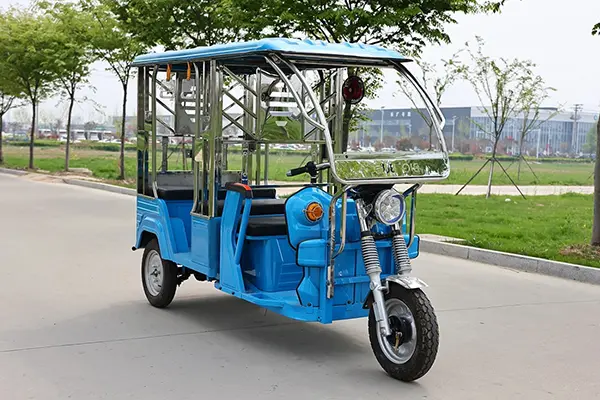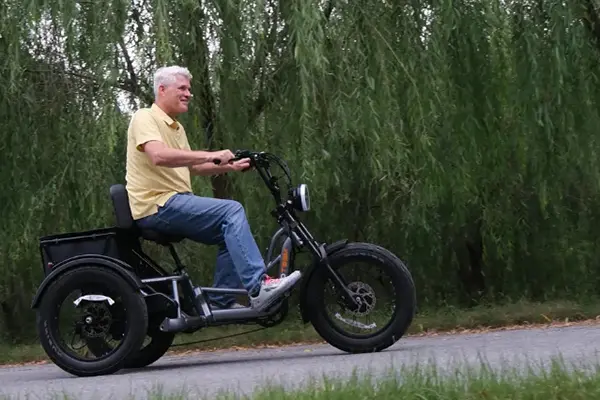For years, the image of a tricycle has been linked to flat, leisurely paths—perfect for cruising through the neighborhood, but not for tackling anything more challenging. As a factory owner who has spent decades in the electric vehicle industry, I’ve heard the skepticism firsthand: "A heavy tricycle on a hill? No way." But I’m here to tell you that the modern electric trike has completely rewritten the rules. The combination of a powerful motor, smart gearing, and thoughtful design has turned the humble trike into a surprisingly capable hill-climbing machine. This article will break down exactly how an electric tricycle conquers an uphill ride, what features make a difference, and how you can confidently choose an e-trike that won’t leave you stranded at the bottom of a slope.
What Makes Climbing a Hill on a Tricycle Different from a Bike?
The first thing to understand is the fundamental difference in physics between a two-wheeled bike and a three-wheeled trike on a hill. On a traditional bicycle, a rider can stand up on the pedals, using their body weight to generate more force and keep the bike moving uphill. This is a dynamic, athletic motion. On a tricycle, the rider remains seated. This seated position provides incredible stability but means you can’t use your body weight in the same way. The entire effort has to come from your legs and the vehicle’s drivetrain.
This is why the "electric" part of an electric tricycle is so crucial for hills. Without that electric assist, climbing even a moderate incline on a heavier adult tricycle would be an exhausting challenge. The motor doesn’t just make it easier; it makes it possible. The other key difference is stability. One of the biggest fears for a cyclist on a steep hill is losing momentum and toppling over. With a trike, that fear is gone. The three wheels create a solid, stable platform, allowing you to slow down or even stop on a hill without losing your balance.
How Does an Electric Trike’s Motor Assist on a Steep Incline?
The magic of an electric trike lies in its electric assist system. This system is designed to augment your own power, making you feel like you have superhuman legs. It works in two primary ways: pedal assist and throttle. When you start to pedal up a hill, a sensor detects your effort and tells the motor to kick in, providing a powerful boost that makes the ride feel almost effortless. You still feel engaged in the ride, but the strain of the incline is dramatically reduced.
Think of it like this: if pedaling up a hill is like walking up a steep staircase, using electric assist is like taking an escalator. You’re still moving upward, but the machine is doing most of the heavy lifting. This technology allows a rider of any fitness level to tackle hills that would have been impossible on a non-electric tricycle. The goal of the motor is to provide a smooth, predictable, and powerful assist that makes every ride enjoyable, whether you’re carrying cargo or just out to explore.

Are All Electric Tricycle Motors Good for Hill Climbing?
This is a critical question. Not all electric motors are created equal, especially when it comes to hill climbing. The key metric to look for is torque, which is the rotational force the motor can produce. High torque is what gets you moving from a standstill and pulls you up a steep slope. While motor wattage (e.g., 750w) is a good general indicator of power, torque is the real star of the show for hills.
There are different types of motors used on an electric trike:
- Front Hub Motor: These are located in the hub of the front wheel. They are simple and effective for general riding but can sometimes lack the traction needed on a very steep or loose uphill surface.
- Rear Hub Motor: Located in the hub of one of the rear wheels, these motors generally provide better traction for climbing, as the rider‘s weight is naturally over the rear of the trike. Many powerful fat tire electric trikes, like those from Addmotor, use robust rear hub motors.
- Mid-Drive Motor: This motor is located in the center of the bike‘s frame, where the pedals are. Its major advantage is that it drives the chain directly, meaning it can leverage the trike‘s gears. This makes it incredibly efficient and powerful for climbing the steepest hills.
For serious hill climbing, a high-torque rear hub motor or a mid-drive motor is your best bet.
What Role Do Gears Play When Riding a Tricycle Uphill?
An electric motor is powerful, but it’s even more effective when paired with a good set of gears. Gears on a bicycle or tricycle are like the transmission in a car—they allow you to use the power source (your legs and the motor) more efficiently across different speeds and terrains. When you approach a hill, you shift down to an easier gear. This allows you to pedal faster and more easily, even as the trike slows down.
It’s a common mistake for a new rider to stay in a high gear and try to power through an incline. This puts immense strain on your knees, the chain, and the electric motor. The proper technique is to anticipate the hill and shift into a low gear before you start the climb. This keeps your pedaling cadence smooth and steady, allowing the motor to operate in its optimal range. A trike with a wide range of gears gives you more options to find that perfect, comfortable cadence for any hill on your route.
Why are Fat Tires a Game-Changer for an Uphill Ride?
You’ve probably seen them—the big, beefy tires that make an electric trike look like a monster truck. These are fat tires, and they are more than just a style choice. For an uphill ride, they offer two huge advantages: superior traction and a smoother journey.
Traction is the grip your tires have on the ground. When you climb a hill, especially a steep one, you are putting a lot of force through the wheels. Standard tires can sometimes slip on loose gravel, wet leaves, or uneven pavement. Fat tires, with their massive surface area, provide a much larger contact patch with the ground. This translates to incredible grip, giving you the confidence to power up a slope without worrying about spinning out. Brands like Sixthreezero and Addmotor have popularized the fat tire electric trike for this very reason. The second benefit is comfort. Fat tires can be run at lower pressures, allowing them to act as extra suspension, soaking up bumps and making the ride on any terrain far more comfortable.

Is an Adult Tricycle with Three Wheels Stable on a Hill?
Absolutely. In fact, stability is the number one reason many people choose an adult tricycle over a standard electric bike. This advantage becomes even more apparent on a hill. While a two-wheeled bike requires constant balance, especially at the low speeds of a hill climb, an electric tricycle is always planted and secure. You can focus all your energy on pedaling and steering without the mental effort of balancing.
When riding a tricycle uphill, the center of gravity naturally shifts backward. The two wheels at the rear create a wide, stable base that prevents any feeling of tippiness. This makes the experience much safer and more confidence-inspiring, particularly for older adults or riders who may be new to electric bikes. Whether you’re starting from a dead stop on an incline or navigating a tricky corner on a slope, the inherent stability of the trike design keeps the ride predictable and secure. This is why our commercial models, like the EV5 Electric passenger tricycle, are built on a tricycle platform for maximum safety.
What are the Best Techniques for a Rider to Climb a Hill on an Electric Trike?
Having a capable electric trike is half the battle; using the right technique will make you a true hill-climbing pro. Here are a few tips to make your next uphill ride a breeze:
- Build Momentum: Approach the hill with a bit of speed. The momentum you carry into the climb will give you a great head start.
- Shift Early: As mentioned, shift into an easier gear before the terrain gets steep. Trying to shift under heavy load can be hard on the drivetrain.
- Power Up: Select a high assist level. If your e-trike has settings from 1-5, don’t be afraid to use assist level 5 for a tough climb. That’s what it’s there for!
- Stay Seated and Lean In: Unlike on a bike, stay seated. You can lean your torso forward slightly. This helps keep some weight over the front wheel for better steering and traction.
- Keep a Steady Cadence: Try to pedal at a consistent, brisk pace. A smooth rhythm is more efficient for both you and the motor than jerky, powerful stomps.
Can a Folding Electric Trike Still Tackle Hills Effectively?
A folding electric trike is a marvel of convenience, perfect for those with limited storage space or who want to transport their trike in a car. But can this compact design handle a hill? The answer is yes, with some considerations. The primary purpose of a folding frame is portability. To achieve this, some design compromises might be made. The frame can be heavier due to the hinges and locking mechanisms.
However, a well-designed folding electric trike from a reputable brand will still feature a powerful motor and adequate gearing. It will absolutely be able to handle moderate hills and make running errands in a hilly neighborhood much easier. It may not be the ideal choice for someone who lives at the top of a very long, steep incline, but for most users, its hill-climbing ability is more than sufficient. The key is to look at the motor’s power and the available gear range, just as you would with a non-folding trike.

How Do I Choose the Right Electric Tricycle for My Hilly Route?
If you know your daily ride involves hills, choosing the right electric tricycle is key to your long-term happiness. When comparing models, look past the color and focus on the components that make climbing easier.
Here’s a quick checklist:
| Feature | What to Look For | Why It Matters for Hills |
|---|---|---|
| Motor | High torque. A 750w hub motor is a great start, but a mid-drive motor is the ultimate hill climber. | Torque is the twisting force that gets you up the incline without strain. |
| Battery | Higher voltage (e.g., 48V) and amp-hours (e.g., 15Ah+). | Climbing hills uses more power. A bigger battery ensures you won’t run out of assist halfway up. |
| Gears | A 7-speed system or more. Look for a large cog on the rear cassette. | More gears give you more options to find the perfect cadence for any slope. |
| Tires | Consider fat tires for maximum traction and comfort. | Better grip prevents slipping and provides a smooth ride on uneven surfaces. |
| Frame | A sturdy, well-built frame, especially a step-through design for easy mounting. | A strong frame, like those on our durable Electric cargo tricycle HJ20, can handle the extra stress of hills. |
| Warranty | A good warranty on the motor, battery, and frame. | This is a sign of a manufacturer’s confidence in their product’s durability. |
Finally, nothing beats a test ride. If you can, try to ride the trike on a small hill to feel how the assist kicks in and how the bike handles.
Pedal Assist vs. Throttle: What’s Best for an Uphill Climb?
Most electric trikes offer two ways to use the motor: pedal assist and a throttle.
- Pedal Assist System (PAS): This system provides power only when you are actively pedaling. You can choose from several assist levels (e.g., 1 through 5). For a long, steady tricycle uphill climb, using a high setting like pedal assist level 5 is ideal. It provides a consistent boost, conserves battery better than the throttle, and still gives you a bit of a workout without the fatigue.
- Throttle: The throttle is usually a twist grip or a thumb lever. It gives you power on demand, even if you aren’t pedaling. This is incredibly useful for getting started from a stop on a steep incline. It’s also great for that final push over the crest of a hill when your legs are tired. Many riders use a combination of both: pedal assist for the main climb and a blip of the throttle for the toughest spots.
Key Takeaways
The idea that a tricycle can’t handle a hill is a thing of the past. Modern technology has made the electric trike a formidable climbing machine. Here are the most important things to remember:
- The Motor is Key: A powerful, high-torque electric motor is the single most important feature for making an uphill ride not just possible, but enjoyable.
- Gears are Your Friend: Use your gears! Shifting to a lower gear before you climb makes a massive difference for you and the motor.
- Stability is a Superpower: The inherent stability of a three-wheeled trike makes it a safer and more confidence-inspiring choice for climbing than a two-wheeled bike.
- Technique Matters: Building momentum, shifting early, and maintaining a steady cadence will help you conquer any hill.
- Choose Wisely: For hilly terrain, invest in a trike with a strong motor, a large battery, a good gear range, and consider fat tires for superior traction.
Post time: 10-29-2025




